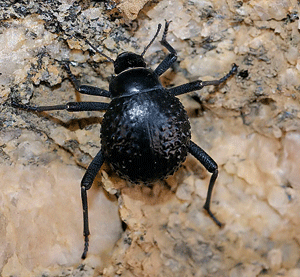
|
Published:
Biomimicry to help capture water from air?
A team of engineering and chemical researchers from the University of Sydney has been investigating a new technology for capturing water from moist air. The technology is inspired by the clever use of surface structuring on the back of a beetle native to the Namib Desert in southern Africa known as the Stenocara beetle.

|
|
The bumps on the Stenocara beetle’s back include hydrophilic and hydrophobic areas that, together, can collect water. Credit: Hans Hillewaert
|
The Stenocara beetle has an extraordinary exoskeleton that is covered in bumps. The peaks of these bumps are water-loving and smooth, whereas the troughs are covered by a micro-structured wax coating that is highly water-repellent. This structure and chemistry allows the beetle to collect droplets of water condensing from the moist winds blowing at dawn in the desert, and to convey the droplets to its mouth.
The research, funded by the University of Sydney Institute for Sustainable Solutions, is investigating how to translate this concept into a viable technology for water collection devices to be used in our drought-stricken cities.
‘This new technology is based on the idea of designing patterned hydrophilic/hydrophobic surfaces which mimic the Stenocara beetle exoskeleton. Our approach uses principles of polymer dewetting to produce artificial patterns,’ says Chemistry Lecturer, Dr Chiara Neto.
Postdoctoral fellow, Dr Stuart Thickett, adds: ‘We have shown that these patterns can successfully condense moisture from the atmosphere, and we are looking into ways to fabricate them on large plastic sheets. These could collect water from fog-laden winds, and convey it via pipes to water tanks.’
Associate Professor Andrew Harris from the Department of Chemical and Biomolecular Engineering hopes that ultimately, such water-capture devices would be installed on top of escarpments near beaches.
‘These could collect many litres of water during the night, and then be folded away during the day,’ he says. ‘The collection of water would be localised, and the water could be used locally for irrigation or in our homes.’
Contact: |
Associate Professor Andrew Harris, |



